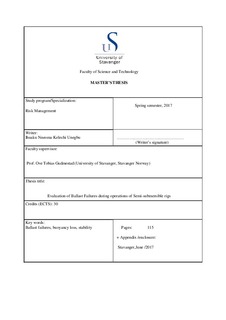| dc.description.abstract | Offshore drilling is an operation performed to explore for and extract hydrocarbon beneath the seabed. The drilling operation is a very sensitive and extremely risky task and can be carried out from a floating vessel, semi-submersible and so on. Because of the high risk involved in drilling operations, the structural integrity and stability of the platform on which the drilling operation is performed are of uttermost importance to the success of the operation. In recent times, drilling operations are performed on mobile platforms most especially on semi-submersibles, thus the stability of this platform as well as the risk involved are worth given careful considerations and evaluations.
In the past couple of years, the PSA has focused on hazards relating to floating installations and thus requested that more attention should be made by the industry on hazards relating to buoyancy loss and stability. Ballast systems play a very vital role to ensure vessel stability. The main function of the ballast system is to maintain stability and sufficient draft, and also to retain the sheer forces and bending moments within required limits. The ballast system comprises ballast tanks, different network of pipes, pumps and valve, hydraulic power system, electric power system and ballast control system. Failure to properly ballast may lead to accidents which could lead to loss of vessel, death of personnel and environmental disasters as in the case of Ocean Ranger accident in 1982, and Petrobras P-34 FPSO in 2002 (Sobena, 2007).
This thesis is aimed at evaluating the risks involved in ballast operations, by identifying the various failure modes of semi-submersible ballast systems and we will consider possible barriers and consequences due to the ballast system failure during drilling operation. The thesis focuses primarily on the failure mode effect and criticality analysis (FMECA) of the main components of the semi-submersible’s ballast system by determining the failure causes and failure modes that could influence each components performance, and thus identifying the most critical component(s). Also the Structured What-If Technique (SWIFT) is used to compensate for hazard identification for the unidentified hazards (i.e., human errors), in the FMECA. By studying the most critical system components, a qualitative risk analysis is conducted to model accidental sequences by using the fault tree method to establish the chain of failure events.
In addition to this, a stability analysis of a typical semi-submersible based on ballast system is performed to assess the criticality of different ballast failure conditions such as damage condition, and ballast failure under different environmental conditions such as under harsh environment, polar low occurrence. In achieving these objectives, both qualitative risk analysis and evaluation methods are adopted. | nb_NO |
